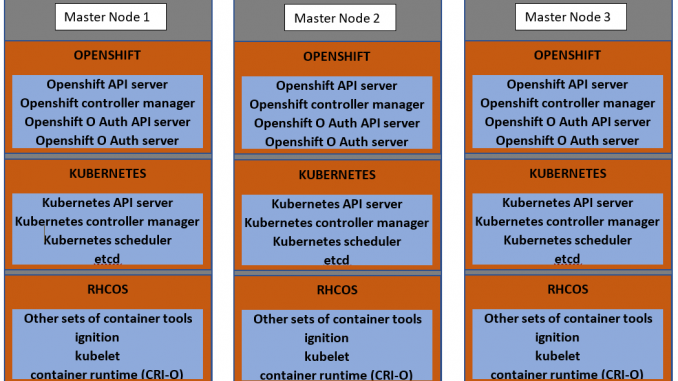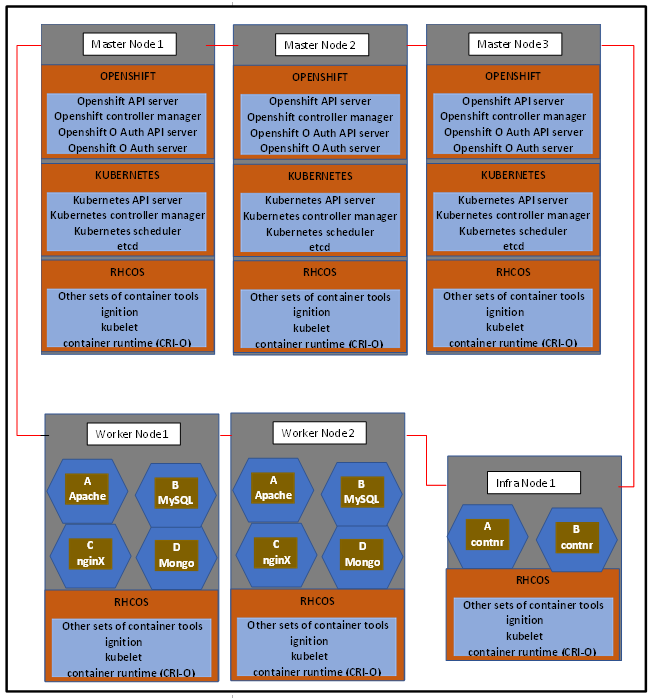
In this lesson, you will understand everything about how to install OpenShift Container Platform.
Installing OpenShift
Just like Kubernetes, the OpenShift container platform can be installed on bare metal, VMs, or as a managed service in the cloud. This is a very important lesson because the installation of the OpenShift container platform takes a different approach as compared to the Kubernetes cluster installation.
So, please flow along with me. You can ask questions in the description section below or in the comments section below. You can also subscribe to our newsletter for courses like this.

OpenShift has two major installation methods which are the installer provisioned infrastructure, and the user provisioned infrastructure
1. The installer provisioned infrastructure (IPI)
The phrase “installer provisioned” means that an installer program will be responsible for deploying the open-shift cluster on an infrastructure that the installer program itself will provision and maintain. This is a full-stack automation process. This process is fully automated and Openshift manages all the cluster aspects, including the operating system itself.
2. The user provisioned infrastructure (UPI)
An alternative method of installation is the UPI method. You can use the UPI method to install the Openshift cluster if your environment does not support the IPI method. The phrase “user provisioned” means that you, the user, will be the one to prepare and maintain the infrastructure the Open-shift container platform will be deployed on.
This is also known as preexisting infrastructure.
In summary, for the IPI method, the installation program provisions and maintains the infrastructure the Openshift Container platform will be deployed on, while for the UPI method, you, the user, will prepare and maintain the infrastructure the Openshift Container platform will be deployed on.
The IPI method is easier than the UPI method, and I’m sure everyone prefers the easy route to doing things. So, at this point, we can use the IPI method of installation. Unfortunately, not all environments or platforms support the IPI method.
IPI Supported Platform
For the cloud, the platforms that support the IPI method are AWS, Azure, GCP (Google Cloud Provider), Azure Stack-up, Red Hat Open Stack platform, IBM cloud, VMWare Cloud (VMC), and Alibaba Cloud.
For virtualization platforms, we have Red Hat virtualization, and VMWare VSphere.
If you don’t want to use the IPI method, you can also use the UPI method on these same platforms listed above, especially when leveraging the IAAS (infrastructure as a service) platform on the cloud. If you don’t have these platforms but all you have is bare metal or any unknown platform, you will have to use the UPI method.

So you need to ask yourself this important question, which is: what type of installation am I doing? Am I doing the installation on the cloud or am I doing the installation on Prem?
And of course, if you are doing the installation on the cloud, with the platforms that I have mentioned that support the IPI method, you can use the IPI method of installation. And if you are doing the installation on-prem, if the platform supports the IPI method, we can use the IPI method. If the platform does not support the IPI method, you will have to resort to using the UPI method.

Going forward, like I said in the previous lesson, you must have a minimum of three control planes and a minimum of two worker nodes to be able to install the OpenShift cluster. So, you must have this kind of architecture, as seen in the previous lesson to be able to install the OpenShift cluster. And in addition to that, OpenShift installation also requires using a temporary bootstrap server and a services machine.
That means that you must have at least seven servers to be able to install the OpenShift cluster. But hey, I don’t have those kinds of resources. I don’t have seven physical servers. I can’t afford those for now. I can’t even afford to spin up 7 VMs in my environment for now because I have a lot of workload in my environment.
Hence, just as we did during our Kubernetes course, where we had to install the single-node Kubernetes cluster using minikube, we’ll also have to improvise or find a way out by using a single node to run both the master node and the worker node, which means we will need to install a single-node OpenShift cluster.
From the Red Hat perspective, you can install a single-node OpenShift cluster using different approaches. You can install:
1. A single node openshift cluster (SNO) using the assisted installer:
The assisted installer is a GUI that makes the provisioning or installation of the OpenShift cluster easier. To use the assistant installer, you need to log into “console.redhat.com”. You can easily create a Red Hat developer account if you don’t have one to be able to use the assisted installer.
This SNO installation method can be used in a production environment. However, there won’t be any form of high availability, which may, of course, not be the best practice for your organization.
The minimum requirements for this type of installation are
8-core CPU
32GB of RAM, and
120GB of storage.
Again, I ask this very important question: do you have these resources? Can your laptop or desktop accommodate this? Because of those who don’t have these kinds of resources but want to learn and use Openshift for development or testing purposes, Red Hat has come up with a second approach for a single node openshift cluster called:
2. Red Hat OpenShift local.
This is formerly known as a “CodeReady Container” (CRC). With Openshift local, you can install a minimal version of Openshift on your laptop or desktop.
The minimum requirements for this installation are
4 CPU,
9GB RAM, and
35 gigabyte storage.
Some should be smiling by now because most of us have these kinds of resources. And for the purpose of this course, we’ll first be installing the Openshift local, and later on we will also be installing the SNO using the assisted installer. And at the end of this course, I will show you how to install Openshift using the IPI and the UPI methods on bare metal and other cloud service providers.
Before I round off with this lesson, let me quickly address the following: OKD and MiniShift; OpenShift Sandbox, and OpenShift on Cloud.
OKD and MiniShift

OKD, meaning Original Key Distribution, is the community version of Openshift Cluster. The OKD can be installed on various Linux distributions and it is free. It can also be used in a production environment. At least one can make use of the support from the community. But if you want professional support, which is the support from Red Hat, you will need to use the OpenShift container platform.

More so, MiniShift is just like the Kubernetes minikube or the Red Hat Openshift local. The minishift helps to run OKD locally on a single node, and this is a single-node OKD cluster where both the master node and the worker node will run on a single node.
Sandbox for OpenShift
With Sandbox for OpenShift, you can use OpenShift without setup or configuration, and it is free. Furthermore, several developer tools are preconfigured for you using a sandbox for OpenShift – that’s good news for developers.
OpenShift On Cloud
At the beginning of this lesson, I mentioned that OpenShift can be installed on the cloud as IAAS (infrastructure as a service), and as a managed service on the cloud. Yes, this is true. Openshift can be installed on a cloud as a managed service where the cloud provider, for example, Azure and Red Hat, would jointly manage the Openshift container platform for you.
Openshift can also be installed as Openshift dedicated on the cloud. For example, on AWS and GCP, openshift will be managed by Red Hat.
Again, Openshift can also be installed on a cloud as Openshift online. Openshift Online is the Red Hat public cloud application development and hosting platform.
In Summary
We have discussed a whole lot of things. We have talked about the installation of the Openshift container platform using the IPI and the UPI methods. And we said that the IPI method is only available for some platforms on the cloud and on-prem. If your platform does not support the IPI method, you will have to use the UPI method.
We also discussed the single-node Openshift cluster using the assisted installer and using the Openshift local.
We also discussed the OKD, which is the community version of the Openshift cluster, and we talked about the MiniShift, which is used to run the single-node OKD cluster.
We also discussed the sandbox for Openshift, which allows using Openshift without a setup or configuration.
Finally, we discussed various approaches to Openshift on the cloud, such as IAAS (infrastructure as a service), managed service, Openshift dedicated, and Openshift online.
I hope I have been able to do justice to this lesson, I’ll see you in the next lesson, which is the step by step guide of how to install the OpenShift cluster locally on a Laptop or Desktop. Bye for now.
Click Here To Watch Video On How To Install OpenShift Container Platform Explained
Install openshift container
Your feedback is welcomed. If you love others, you will share with others
Leave a Reply